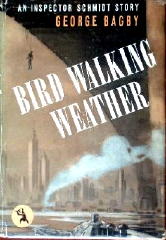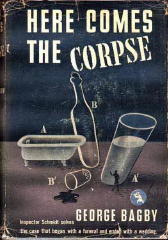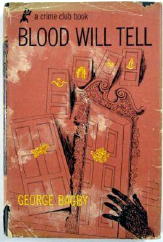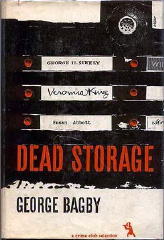Sun 25 Jan 2009
Archived Review: JOHN BUXTON HILTON – Holiday for Murder.
Posted by Steve under Authors , Bibliographies, Lists & Checklists , Characters , Crime Fiction IV , ReviewsNo Comments
JOHN BUXTON HILTON – Holiday for Murder. Diamond, reprint paperback; 1st printing, July 1991. Originally published as Passion in the Peak. US hardcover edition: St. Martin’s Press, 1985. Originally published in the UK by Collins Crime Club, hc, 1985.

This is another in the author’s Inspector Kenworthy series, the fifth in the series published by Diamond. There have been seventeen in all, and they have all been published in the US, surprisingly enough. (For most British mystery writers, there’s always at least one book that doesn’t make the cut with publishers over here — or so it seems.)
Of the ones they’re doing, Diamond is not publishing them in order. One that I read not too long ago was Hangman’s Tide, which originally came out in 1975. In Holiday for Murder, which was written ten years later, Inspector Kenworthy has already retired, but his ability as a detective has spread throughout England so greatly that he’s regarded as very nearly omniscient.
In this book he investigates a strange sort of murder, a hillside automobile accident in the driver disappears, only to show up later, very much dead, some distance away. The dead man is a notorious womanizing rock musician (all of which are (to some degree) very much synonymous) who has the leading role (that of Christ) in a non-denominational/ecumenical Passion play now in the stages of rehearsal in the small village of Peak Low.
Practical jokes at the expense of two different Mary Magdalene’s have preceded the accident, but the murder was apparently committed for other reasons. The villagers, various policemen, and the many actors, singers, electricians and so on involved in putting on the extravaganza are all precisely and individually depicted — Hilton’ s primary strength as a writer.
The solution to the murder is presented in very anti-climactic fashion, strangely enough, as if Hilton felt that the mystery itself wasn’t strong enough to stand on its own.
There is also a red herring — the matter of the match from Doncaster — that is poorly done. Kenworthy seems to know all about before he’s informed, and its significance in the story is none at all. It’s never mentioned again.
But if you enjoy mysteries with small English village settings, read this one anyway. You’ll like it.
[UPDATE] 01-25-09. Strangely enough, while I don’t remember any of the details of this book’s plot, much less whatever flaws I may have found in it, I do remember enjoying reading it, which makes that last sentence pretty much of a guarantee.

One thing that I didn’t change in the review is Kenworthy’s rank. I called him an Inspector, but in Al Hubin refers to him as a Superintendent. (See below.) The easiest explanation is, of course, that he was promoted sometime during his career.
When Hilton wasn’t writing about Kenworthy, he used Inspector Thomas Brunt as his detective on the case. What really distinguished them from the Kenworthy mysteries, though, is that the six Brunt books took place in England in the late 1800s through the year 1911 or so.
And, for the sake of completeness, Hilton also wrote another six mysteries as by John Greenwood. Inspector Jack Mosley was in all of these. I remember the Mosley books as being somewhat lighter in tone, though I may be in error about that.
Expanded from the Revised Crime Fiction IV, by Allen J. Hubin, here’s a list of all the Kenworthy books —
KENWORTHY, SUPT. SIMON [John Buxton Hilton, 1921-1986.]
Death of an Alderman (n.) Cassell, UK, 1968. Walker, US, 1968. Also published as: Dead Man’s Path, Diamond, pb, 1992.
Death in Midwinter (n.) Cassell, UK, 1969. Walker, US, 1969. (Diamond, pb, 1994.)
Hangman’s Tide (n.) Macmillan, UK, 1975. St. Martin’s, US, 1975. (Diamond/Charter, pb, 1990.)
No Birds Sang (n.) Macmillan, UK, 1975. St. Martin’s, US, 1978. Also published as: Target of Suspicion, Diamond, pb, 1994.
Some Run Crooked (n.) Macmillan, UK, 1978. St. Martin’s, US, 1978.
The Anathema Stone (n.) Collins, UK, 1980. St. Martin’s, US, 1980. Also published as: Fatal Curtain, Diamond, pb, 1990.

Playground of Death (n.) Collins, UK, 1981. St. Martin’s, US, 1981. (Diamond/Charter, pb, 1991.)
Surrender Value (n.) Collins, UK, 1981. St. Martin’s, US, 1981. Also published as: Twice Dead, Diamond, pb, 1992.

The Green Frontier (n.) Collins, UK. 1982. St. Martin’s, US, 1982. Also published as: Focus on Crime , Diamond, pb, 1993.
The Sunset Law (n.) Collins, UK, 1982. St. Martin’s, US, 1982.

The Asking Price (n.) Collins, UK, 1983. St. Martin’s, US, 1983. Also published as: Ransom Game, Diamond, pb, 1992.
Corridors of Guilt (n.) Collins, UK, 1984. St. Martin’s, US, 1984. (Diamond, pb, 1993.)

The Hobbema Prospect (n.) Collins, UK, 1984. St. Martin’s, US, 1984. Also published as: Cradle of Crime, Diamond, 1991.
Passion in the Peak (n.) Collins, UK, 1985. St. Martin’s, US, 1985. Also published as: Holiday for Murder, Diamond, 1991.
The Innocents at Home (n.) Collins, UK, 1986. St. Martin’s, US, 1987. Also published as: Lesson in Murder, Diamond, 1991.
Moondrop to Murder (n.) Collins, UK, 1986. St. Martin’s, US, 1986.
Displaced Person (n.) Collins, UK, 1987. St. Martin’s, US, 1988.









































